In today’s article we will be examining an often overlooked aspect of Venom. The fact that Spidey was unusually frightened of him.
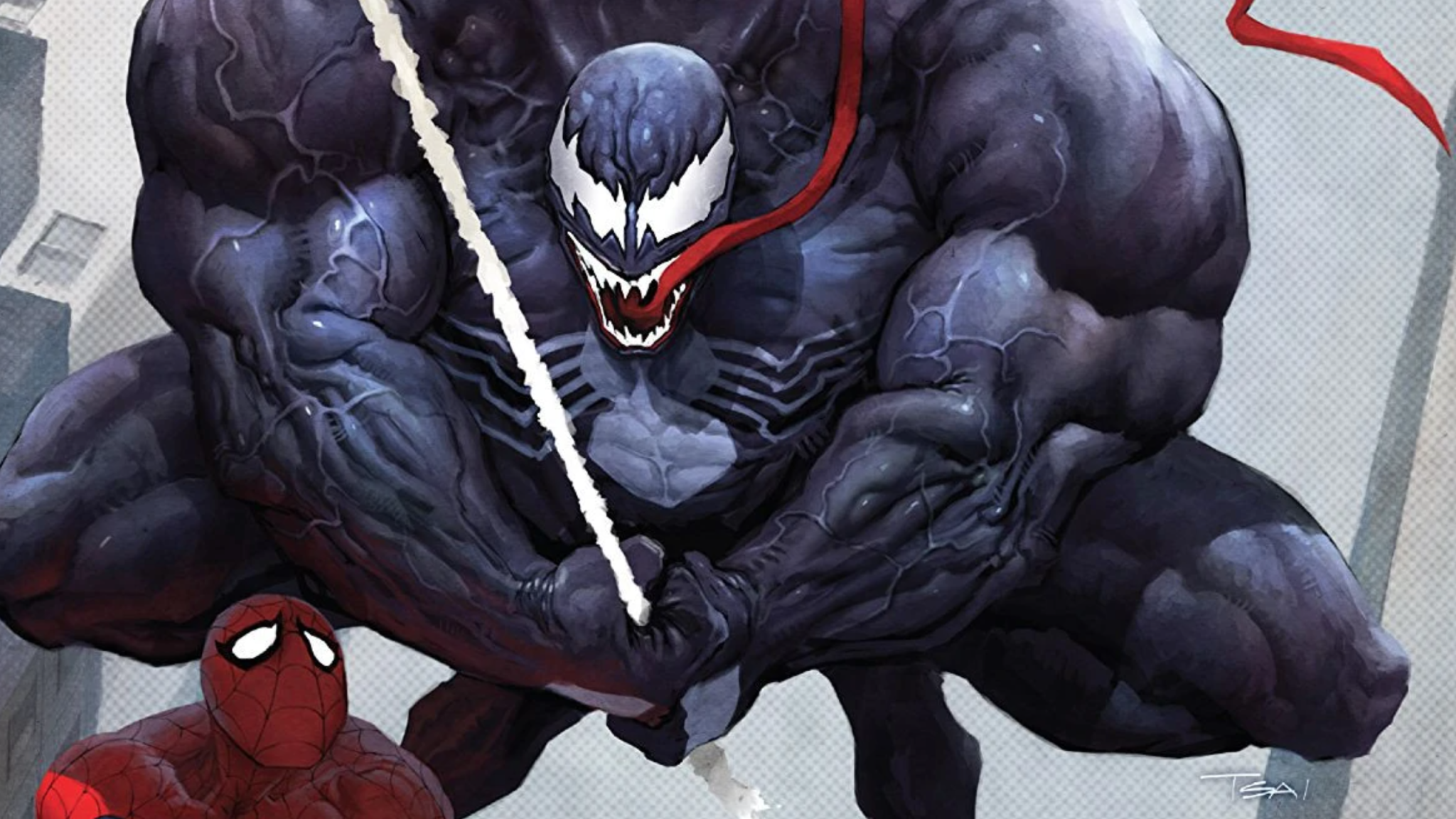
In his ‘Dark Side of the Spider’ essay J.R. ‘Madgoblin’ Fettinger stated the following.
Spider-Man not only demonstrates this during his various encounters with Venom under the Michelinie run but outright states he is fearful of him in ASM #362.

This all got me wondering if there could be any kind of explanation for Spider-Man’s fear of Venom. Eventually I came up with a few possible answers which are all connected to some degree.
Venom just LOOKED scary and had weird powers
The first answer is the most obvious one. Venom just looks plain terrifying.
Now sure, most of Spider-Man’s foes with the right amount of artistic licence can look intimidating but with Venom it’s downright difficult to make him look anything other than intimidating. Furthermore his fear factor has been an integral in-universe component of his character literally from the first time we saw him in ASM #299-300.
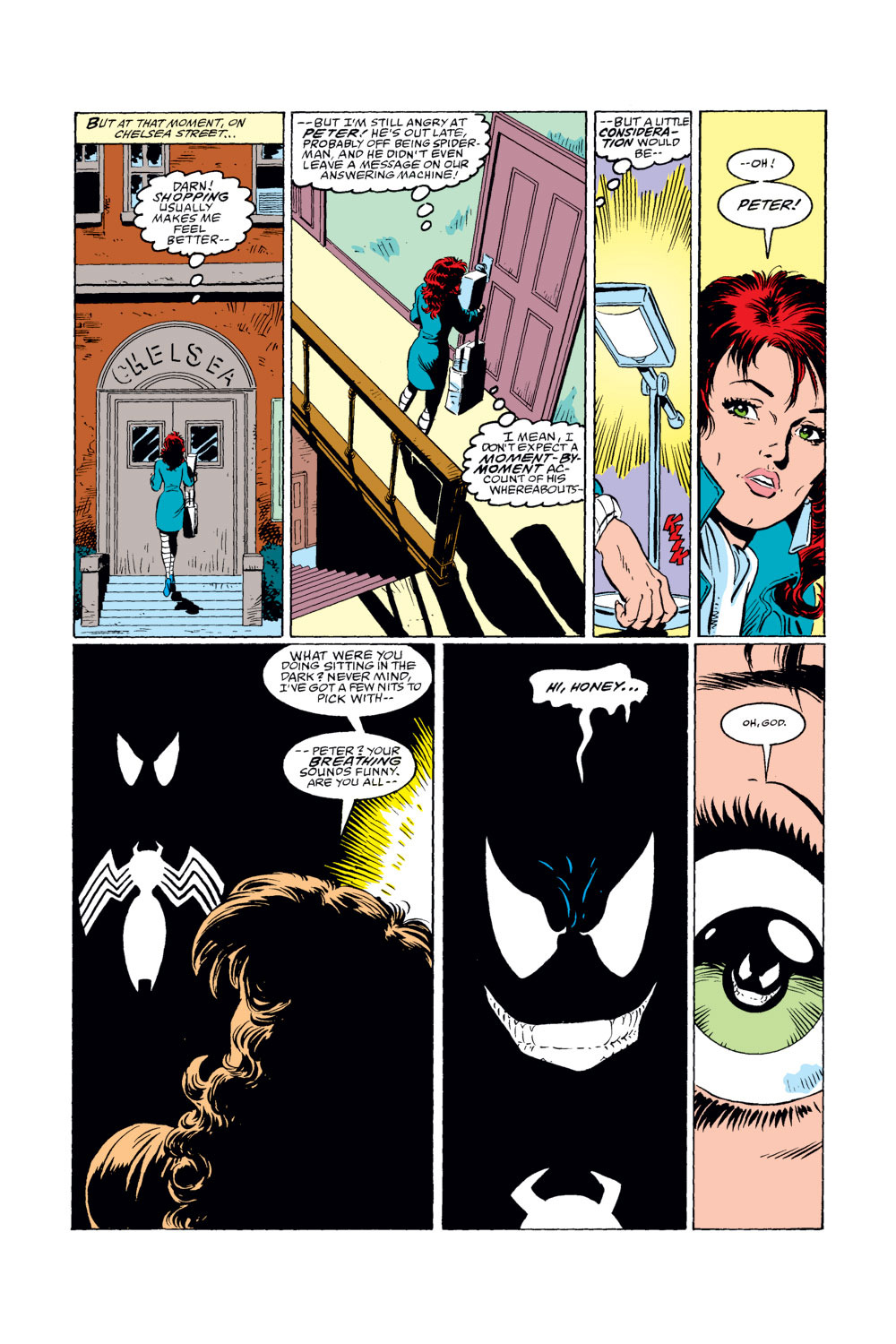

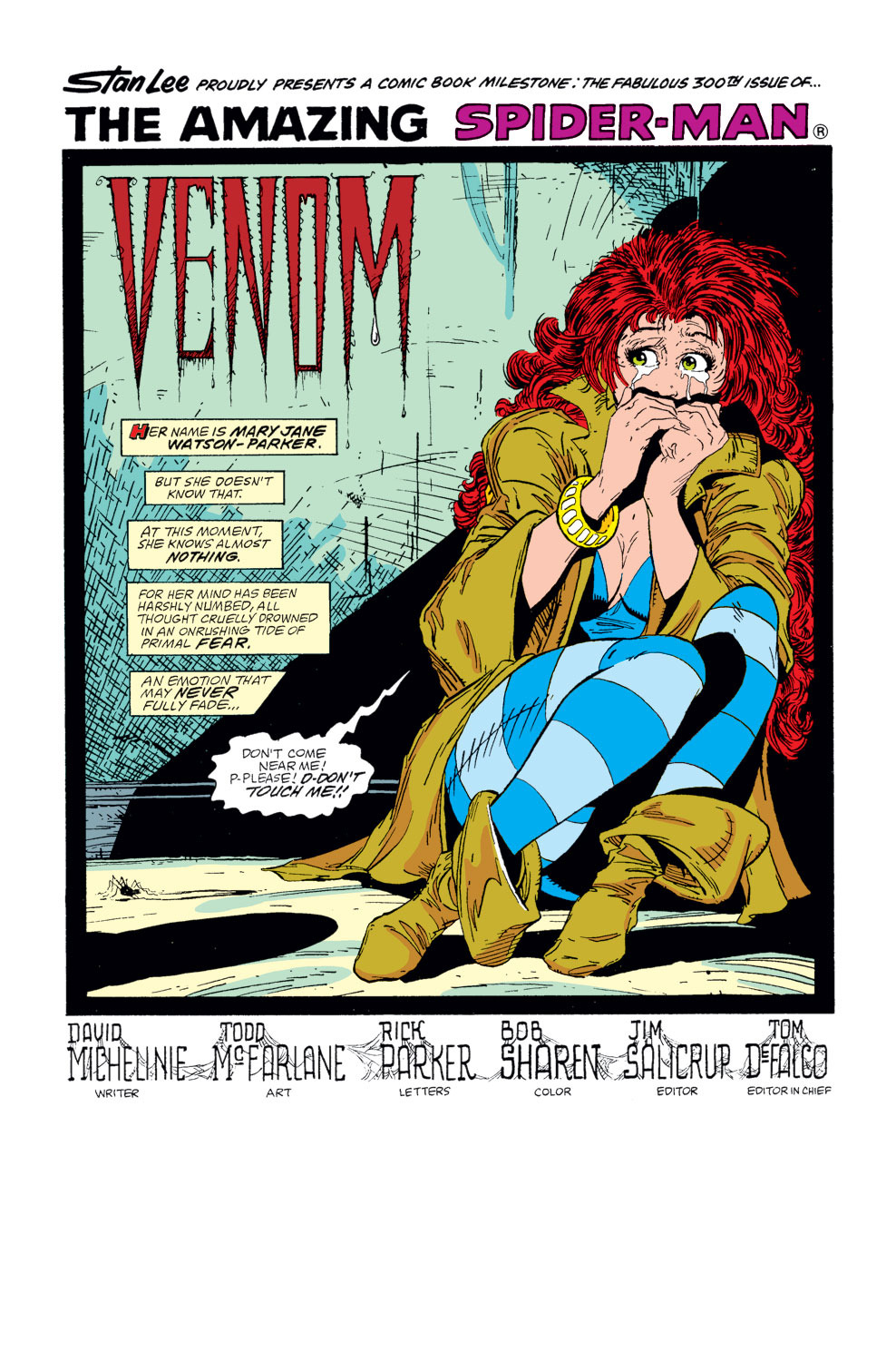
As Fettinger put it in his essay.
Compounding this frightening appearance is the fact that unlike most of Spidey’s recurring foes (exempting other symbiotes and the Lizard) Venom is a literal monster. Those claws teeth and gaping maw aren’t just a normal person in synthetic clothing, they’re part of an organic entity, one that is part human.
Sure Spidey isn’t outright frightened of the Lizard but there are some key differences between him and Venom. For starters Spidey can pity the Lizard as an innocent victim of science gone wrong, a man with an illness who has no control of his actions when said illness flares up. However Venom’s monstrous appearance and abilities are no accident. He is a true monster inside and out even taking his warped moral code into account. He wants to look like that meaning there is no pity factoring into Spidey’s perception of him.
Then you have his powers. Venom’s abilities are likely to freak anyone out because they are simply unnatural. The Lizard for instance is a giant reptile monster and while those don’t exist in everyday life Spidey at least has a basis for understanding that (helped by his own scientific acumen). This holds true many of Spidey’s other foes. Whether they are people with costumes and gadgets or have some kind of genetic mutation there is a real life frame of reference for sand, electricity, etc.
However Venom’s alien status, his living fluid body and the way his powers manifest are distinctly unnatural by Earth standards and human beings tend to be freaked out by both the unknown and things that are visually different from themselves.
Psychologist Martin Seligman explained the latter phenomenon as part of the ‘biological preparedness’ theory. The idea is that human beings are predisposed to develop fears of objects that were real sources of danger in our evolutionary pasts. For example creatures who don’t resemble our general body builds and do not move like us. This is why among the most common human fears across the world is in fact arachnophobia. Spiders neither look like or move like us so instinctively we are afraid of them.
Consequently when confronted with something that does resemble a human but with stark differences it is disconcerting and unnerving. This might even be a partial explanation for why Spider-Man himself is feared by the general public. In the symbiote’s case it’s a living entity like nothing known on Earth.
Venom was extremely powerful
Simply put Venom could be frightening to Spider-Man because he possessed considerable raw power. Venom had better versions of most of Spider-Man’s powers plus shape shifting, invisibility and a costume that could transform into a variety of offensive and defensive weapons.
This is in stark contrast to Spidey’s arch villains like Green Goblin or Doctor Octopus because whilst they were formidable they were categorically not more powerful than he was. When push came to shove Spidey was stronger, faster and in many ways more adaptable fighters than either of them meaning in one-on-one battles they were not particularly intimidating to him. In contrast Venom could replicate Spidey’s powers and to a degree fight like he did which was mostly new and unexpected to Spidey and might have caused him to second guess his own fighting instincts. Not to mention that whole ‘proportional strength of a spider’ thing becomes a problem when your opponent has that same ability but with much bigger proportions of muscle.

Furthermore whilst foes like the Rhino or Electro certainly outclassed Spidey in terms of their powers they were also inferior intellectuals and strategists or else had glaring weaknesses. This meant that Spidey could easily outsmart them or exploit their Achilles heels.
Spider-Man has certainly outwitted Venom more than once but those occasions often involved luck or a mistake on Venom’s part. In their first encounter Venom made the mistake of overusing his webbing thus when Spidey made him fall he was unable to catch himself. In their fourth battle on a deserted island Spidey was fortunate enough to come across a skeleton he could use to masquerade as his own corpse. Even instances where Peter has outsmarted Venom without the aid of luck (such as their second battle in ASM #317) it’s clear the same trick will not twice.
Unlike more thuggish foes like Rhino or Sandman Venom is far more cunning and quick to adapt meaning Spidey cannot rely upon a standard tactic against him or easily outwit him.
Venom knew Peter’s identity
This is another obvious point but a poignant one. Venom knew Peter’s secret identity and with that knowledge gained further insight into other aspects of his private life. In fact Peter first learns of Venom’s existence when he finds his wife terrified over his invasion of their home. Later in ASM #317 he even shows up on Aunt May’s doorstep and makes very direct threats against her.
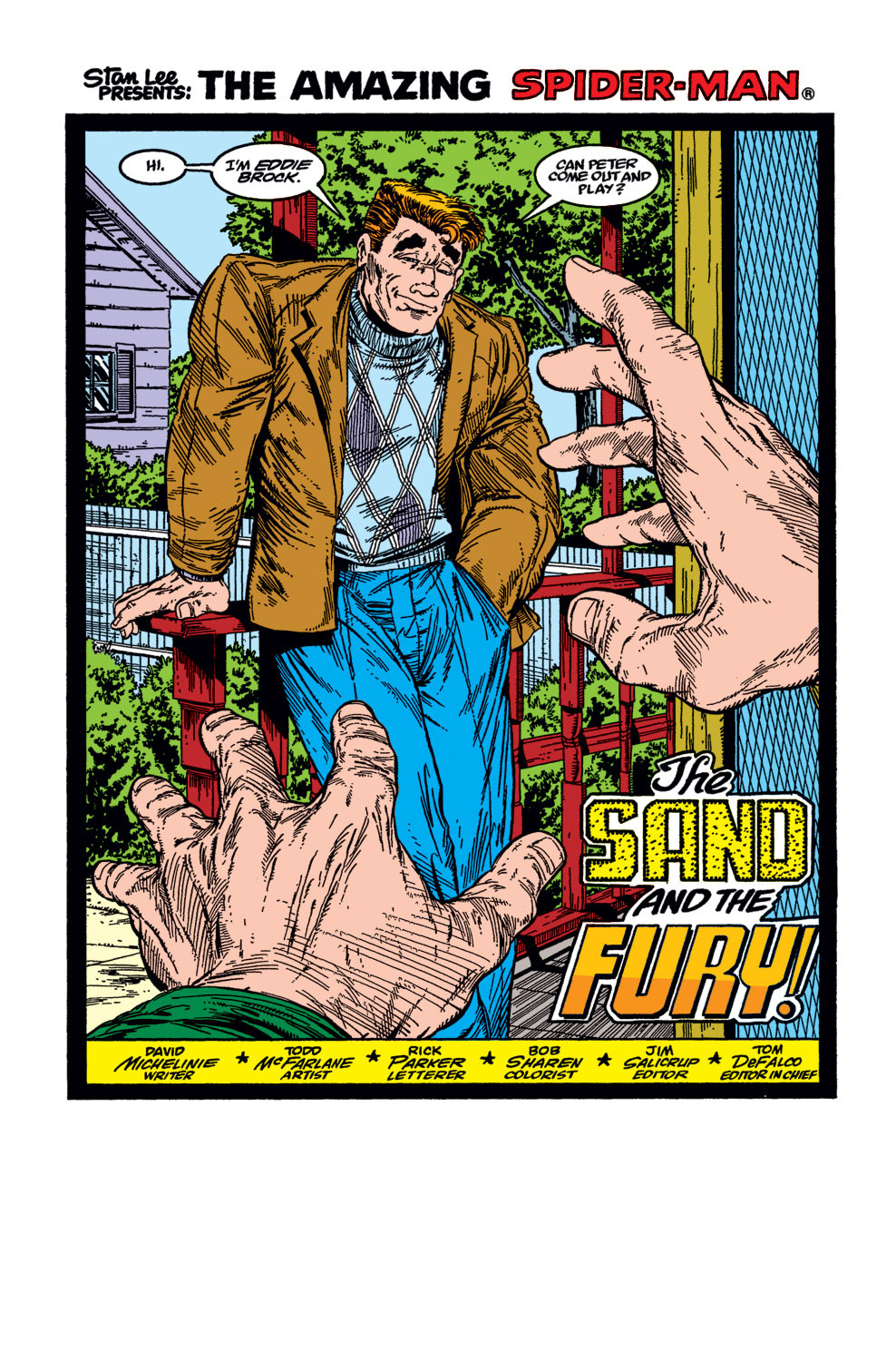

The psychological effect of this should not be underestimated. For many of us our homes, our rooms or our own personal private spaces in general are incredibly relevant to our sense of personal safety.
They are our own personal ‘safe spaces’ if you will and Venom very directly violated those spaces multiple times and made clear physical threats to the people Peter cares most about. And frankly these are far more direct and deliberate threats and violations than other villains up until ASM #300 had perpetrated.
In fact most villains who violated Peter’s private life did so by chance (Doctor Octopus in the Silver Age), didn’t know his real identity (the Sinister Six also in the Silver Age) or could be reasoned with in some regard (Puma). Even foes like Green Goblin were not people whom Peter actually saw enter and violate his private space, even if he saw the aftermath of them doing so.*
Norman and Harry Osborn are among the very few exceptions and sure enough in the Silver Age and beyond we saw Peter clearly unnerved by their knowledge of his private life and ability to invade it.
The caveat with the Osborns when compared to Venom was that Peter at least knew he was physically stronger than either of them and that he could hold them in check to some degree since he could expose either of their identities. In both cases the familiarity with both men likely contributed to Peter’s lack of fear regarding them. At the end of the day he knew they were warped men but men they nevertheless were. Venom though was one part a delusional psychotic and another part a distinctly inhuman alien.**
Venom didn’t trigger the Spider Sense
Compounding the last two points is Venom’s ability o disable the Spider Sense.
We need to appreciate just how critical this power is for Peter. He relies upon it in a way he just doesn’t with any of his other abilities. It helps him web-swing, saves him from immediate physical injury, safeguards his secret identity and even works during his sleep. We can observe in Web of Spider-Man #18 (Venom’s first off-panel appearance) that Peter is very alarmed by his spider sense giving no warning about a mysterious unseen assailant.

In a way the Spider Sense is a kind of safety blanket for Spider-Man. When all else fails he can at least rely upon that power to help him web-swing, protect his identity dodge bullets, etc. It is in fact critical to his entire fighting and life style as a superhero.
And Venom is the one villain for whom it’s totally useless.***
When you combine this fact with his knowledge of Peter’s private life, his shape shifting/invisibility powers, his overwhelming power and sole drive to murder Peter you can see why Peter would feel intimidated by Venom in a way he isn’t by other foes.
This was a totally irrational person who wanted nothing other than to very violently murder Spider-Man, was aware of who he and his family were, where they all lived, could entirely inconspicuously follow them and invade their homes whenever he liked and for whom Peter’s super powers were of little consequence because he outgunned our hero in every way.****
Remove the super powered aspects and wouldn’t any of us be unnerved if faced with such a person? Especially if we knew the authorities were absolutely helpless against such a person.
The Symbiote freaked Spidey out
Ever since discovering his black costume was a living entity, Spidey has not reacted well to it.
In ASM #258 he is shocked if not freaked out when he learns the costume is a live and is distressed that he cannot remove it.
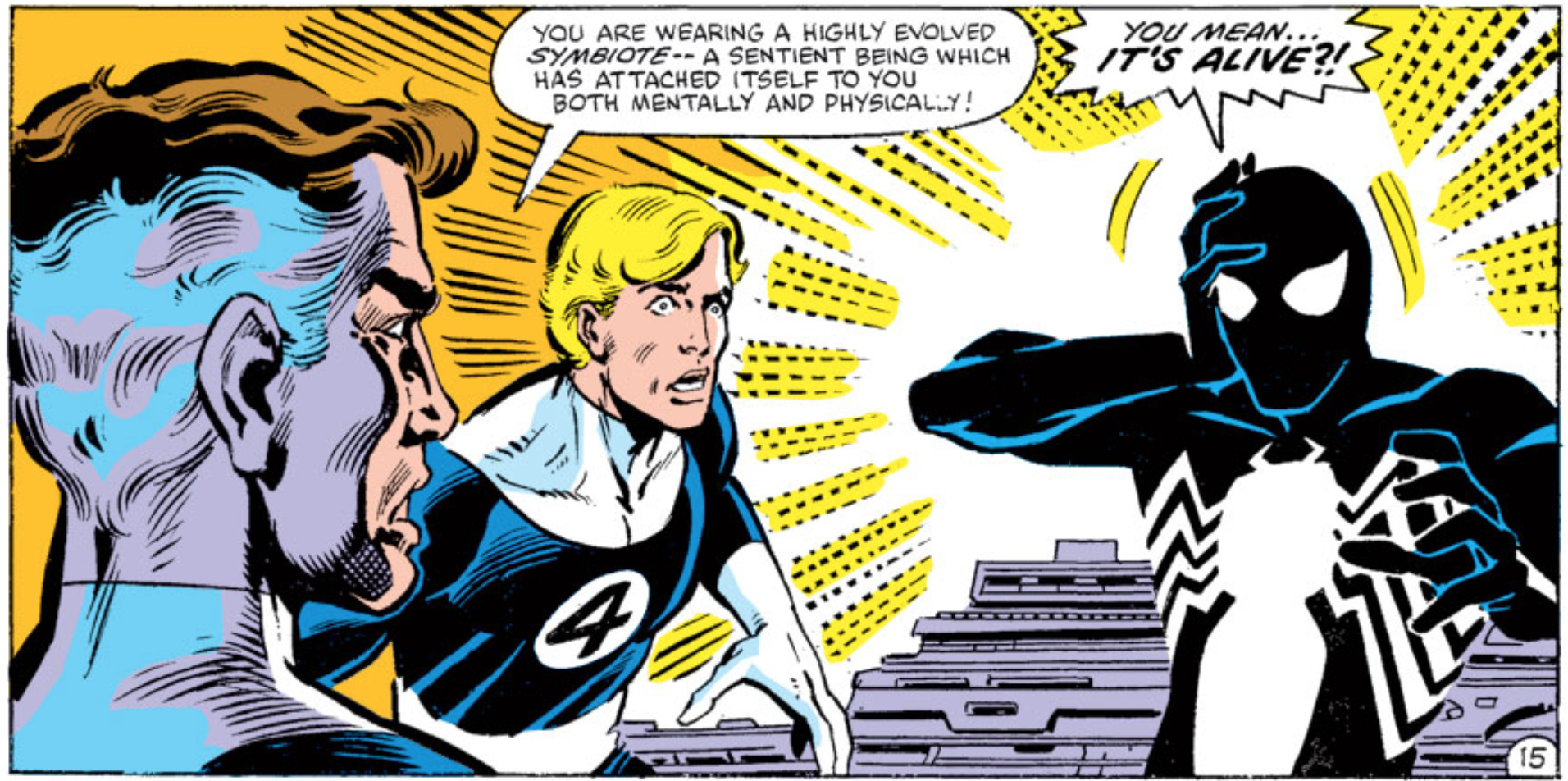
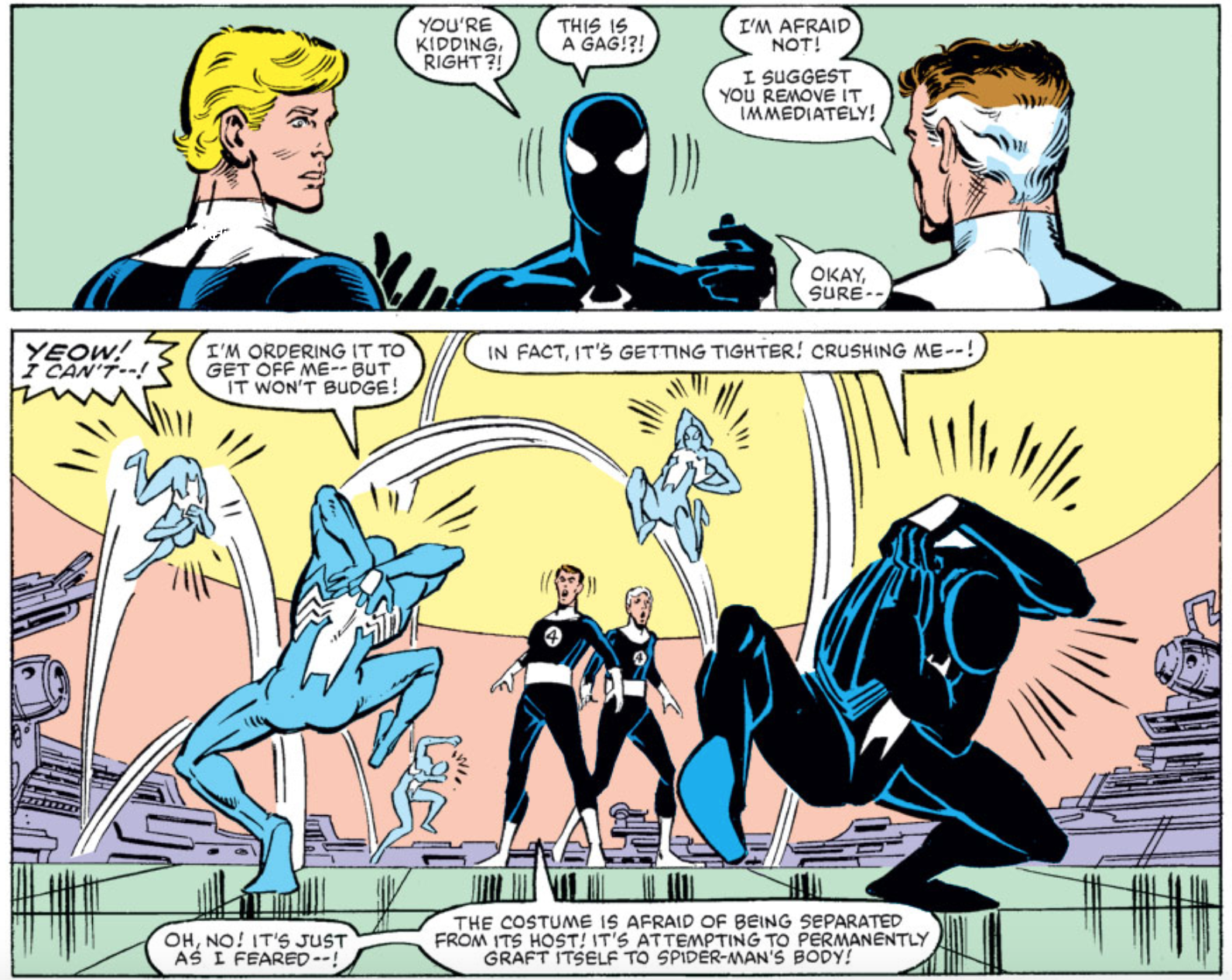

In Spectacular #99 he is again freaked out when Black Cat presented him with a mere cloth version of said costume.
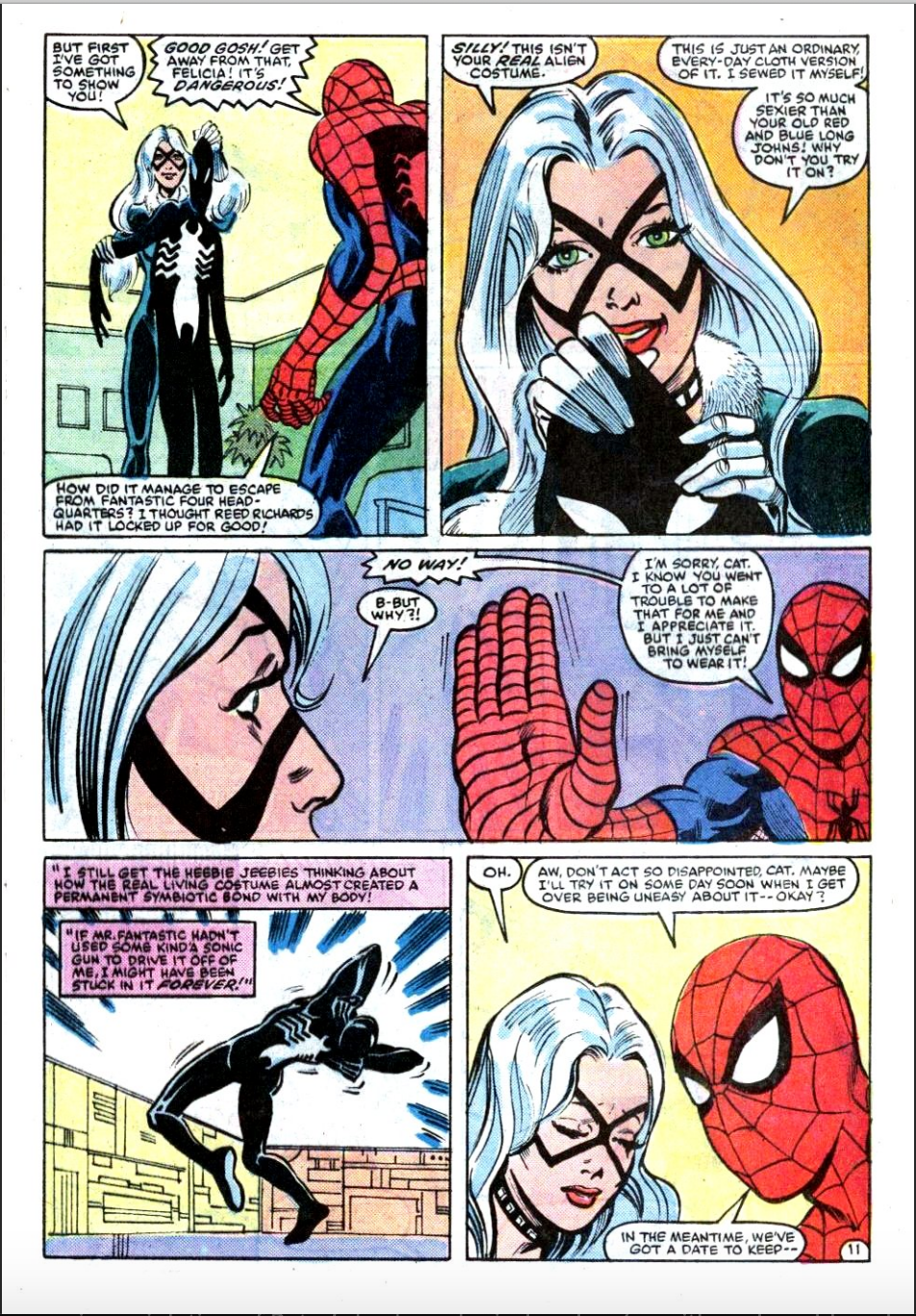
In Spec #100 he even had a horrifying nightmare about the black costume consuming him.
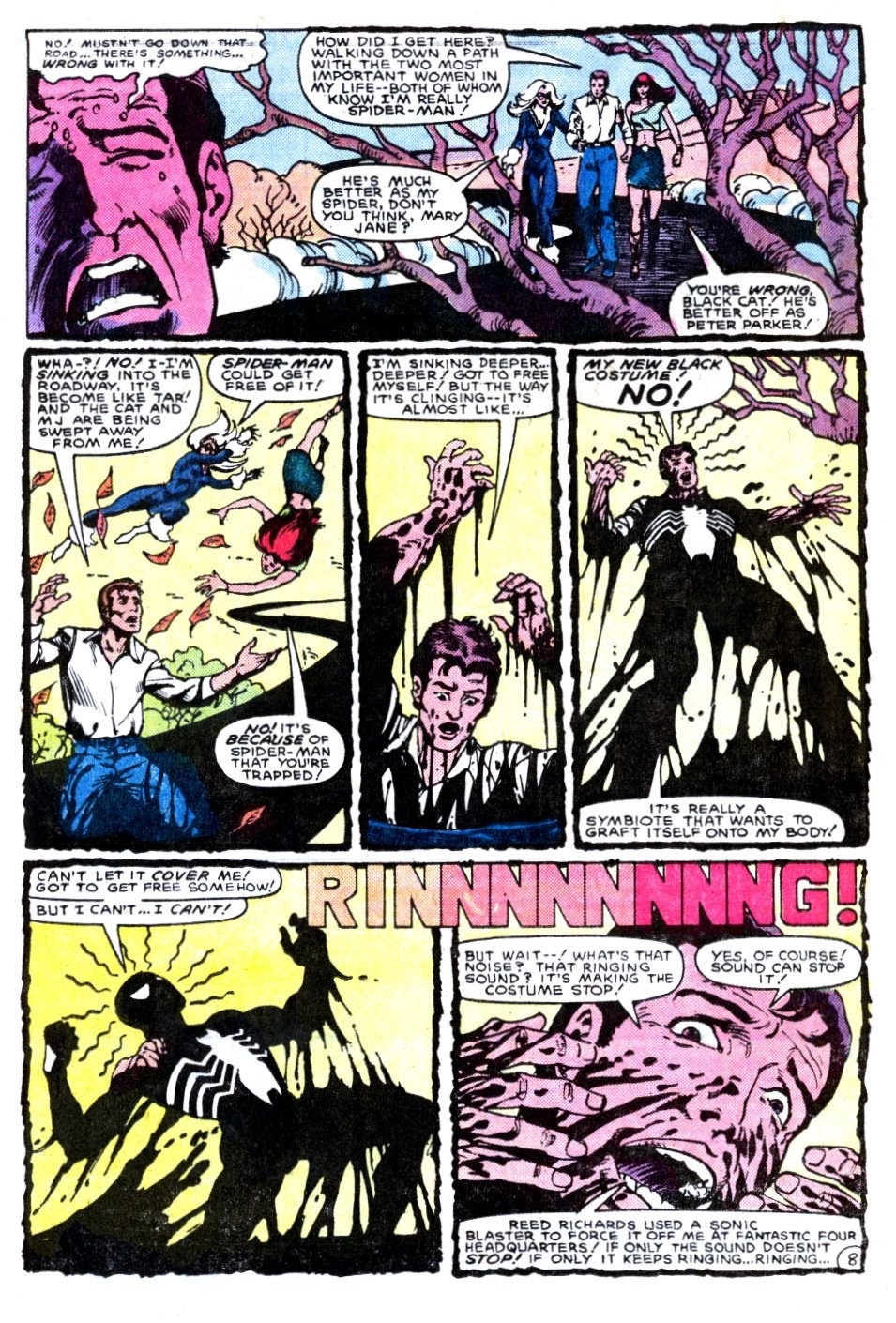
At the end of the issue and Web #1 the symbiote does indeed return by sneaking into his home, disguising itself as his red and blue outfit and then trying to again forcibly bond with Peter.
Whilst the symbiote is only one half of Venom, it nevertheless represents two natural and primal fears for Spidey. The first of these would be what was discussed above in conjunction with Martin Seligman. The second would be a loss of control and a subsuming of his identity.
The symbiote after all wanted to forcibly bond with Peter, making his identity part of a new organism and was controlling him without his knowledge or consent during his sleep.
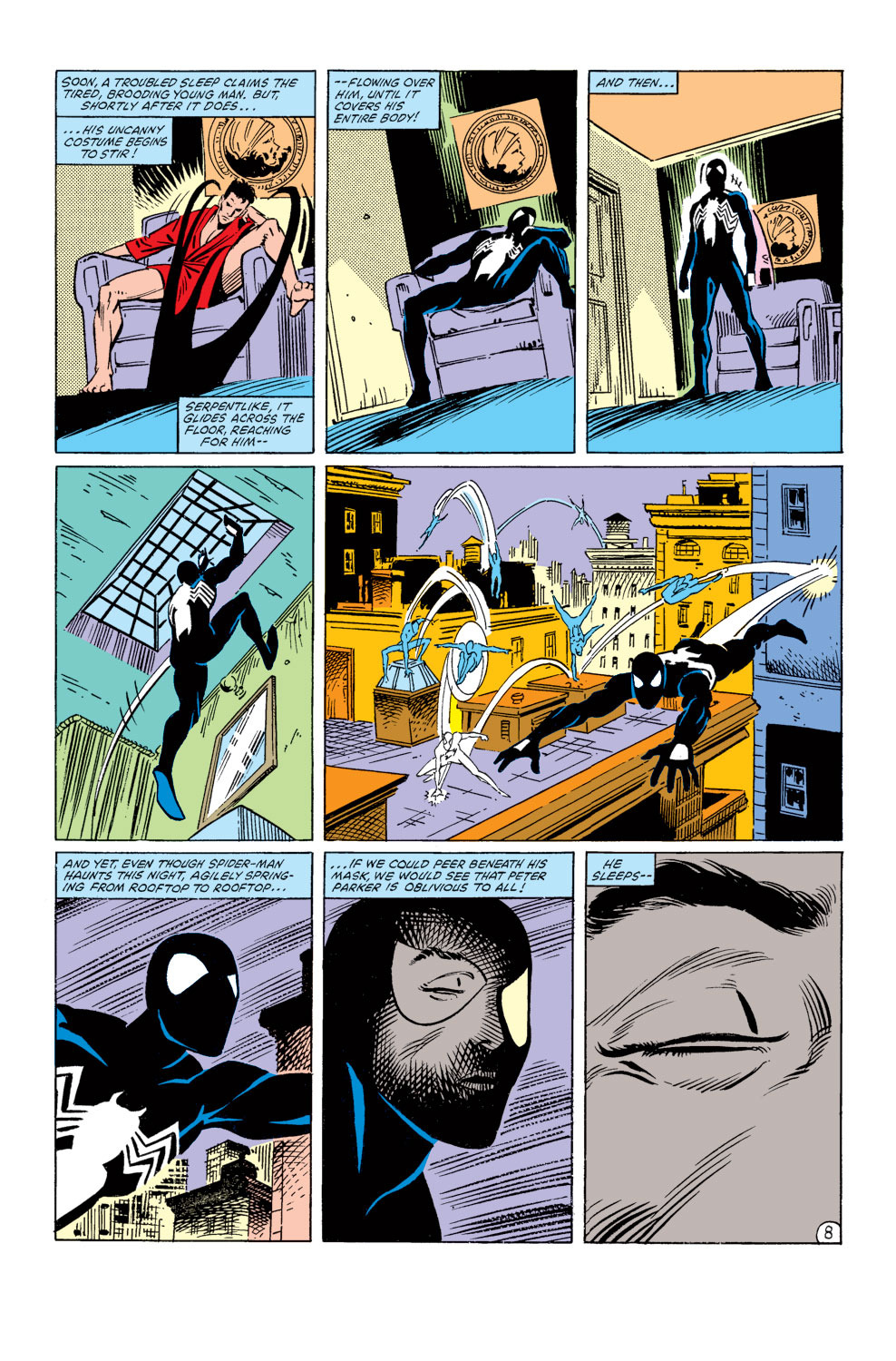
This is very serious violation of Peter’s body and mind and so (as with real world analogies I’m sure any of us could draw) Peter’s fear and distress over the costume is entirely natural whenever he confronts it.
The fact that Spider-Man was seemingly more fearful of Venom following their second battle might even be explained as a result of Peter tricking the symbiote into temporarily bonding with him again. This would have risked his mind and body being violated and controlled once more. Just check out how uncomfortable he is when the symbiote slithers onto his body at the climax of that battle.
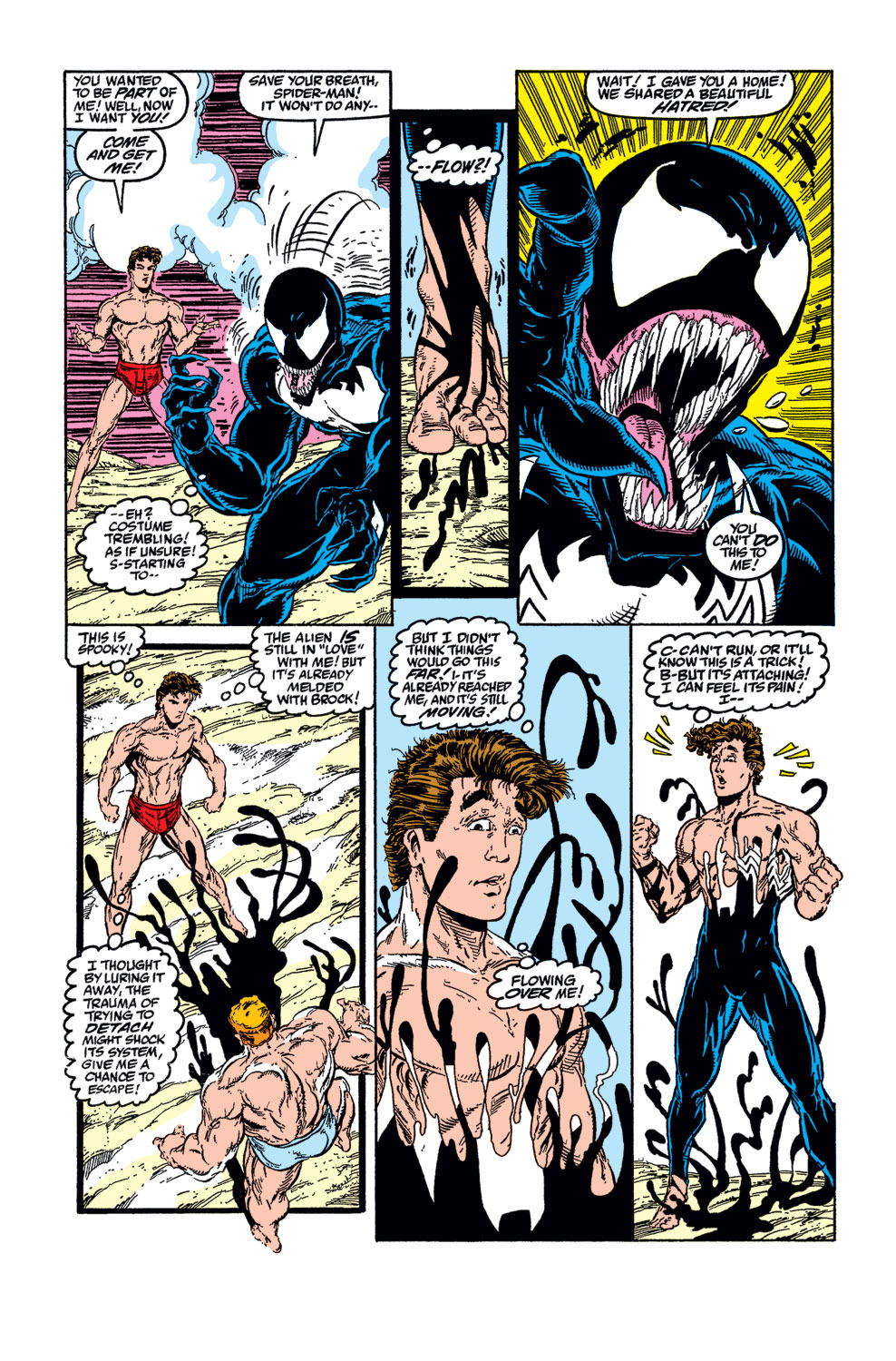
Venom looked like a nightmarish version of himself
Peter’s fear of the symbiote subsuming his identity brings us to our final point.
See Spider-Man has some issues when it comes to his identity. When I say his identity I am not referring to his double life, though that possibly exacerbates what I am going to discuss. I am actually referring to sense of self and individuality.
We can observe this most acutely in ASM #149 when Spidey and his clone (the later to be named Ben Reilly) begin fighting over who is the real deal.
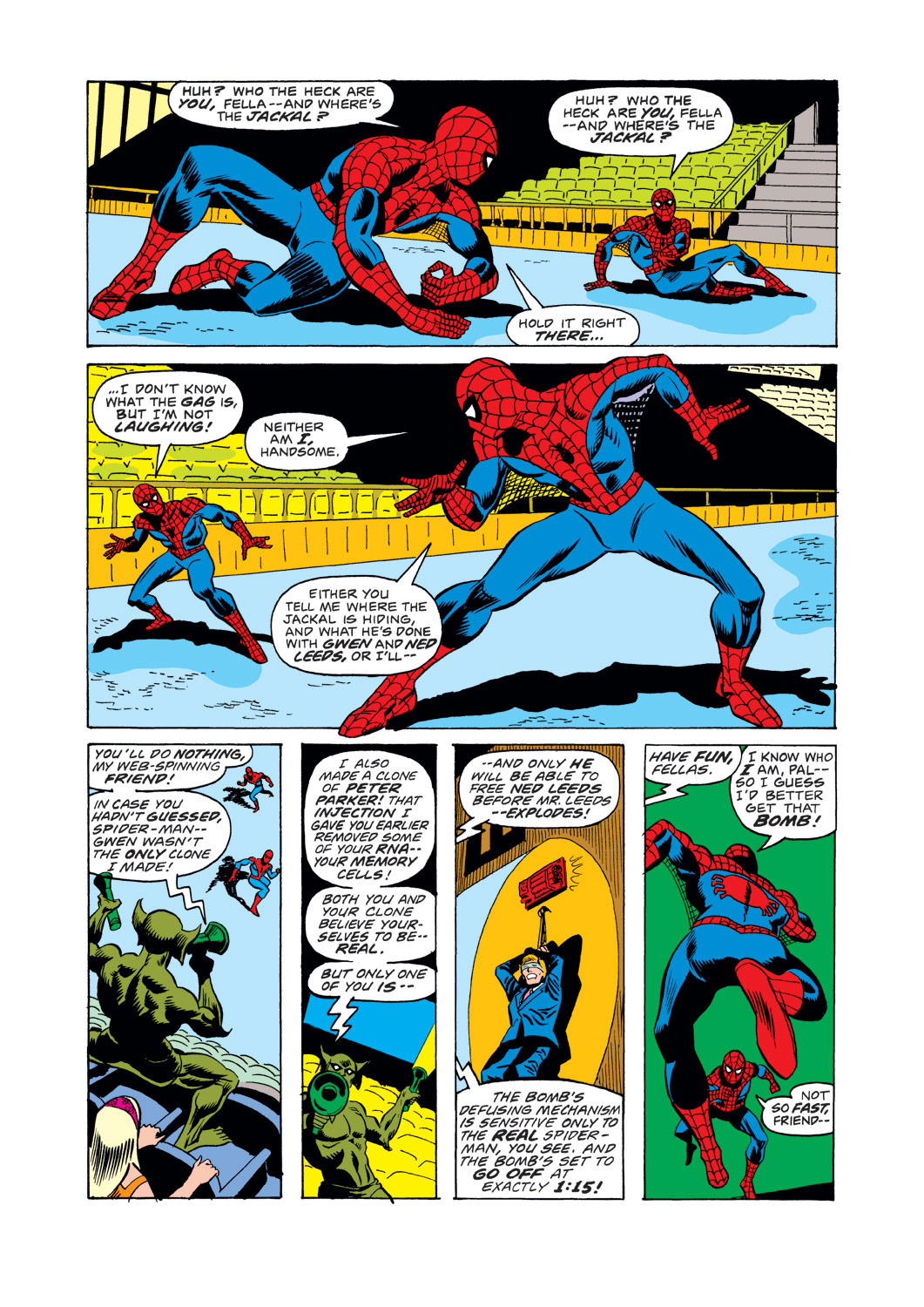
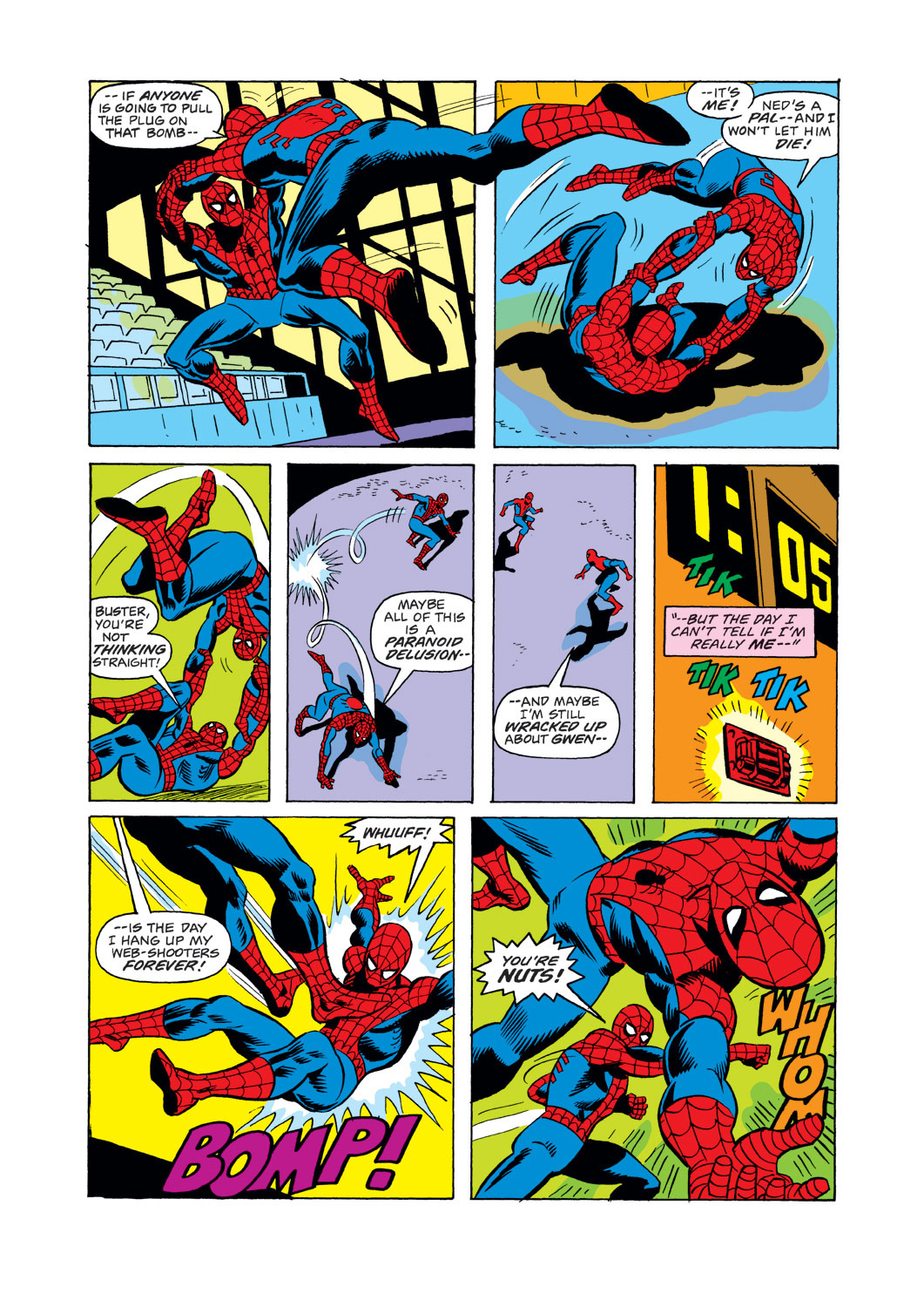
Too circumstantial for you? Well in Spider-Man: the Lost Years #0 the scene is revisited with internal narration from one of the Spider-Men (we can’t be sure which one) and they talk about how horrifying and unsettling facing a duplicate of themselves is.

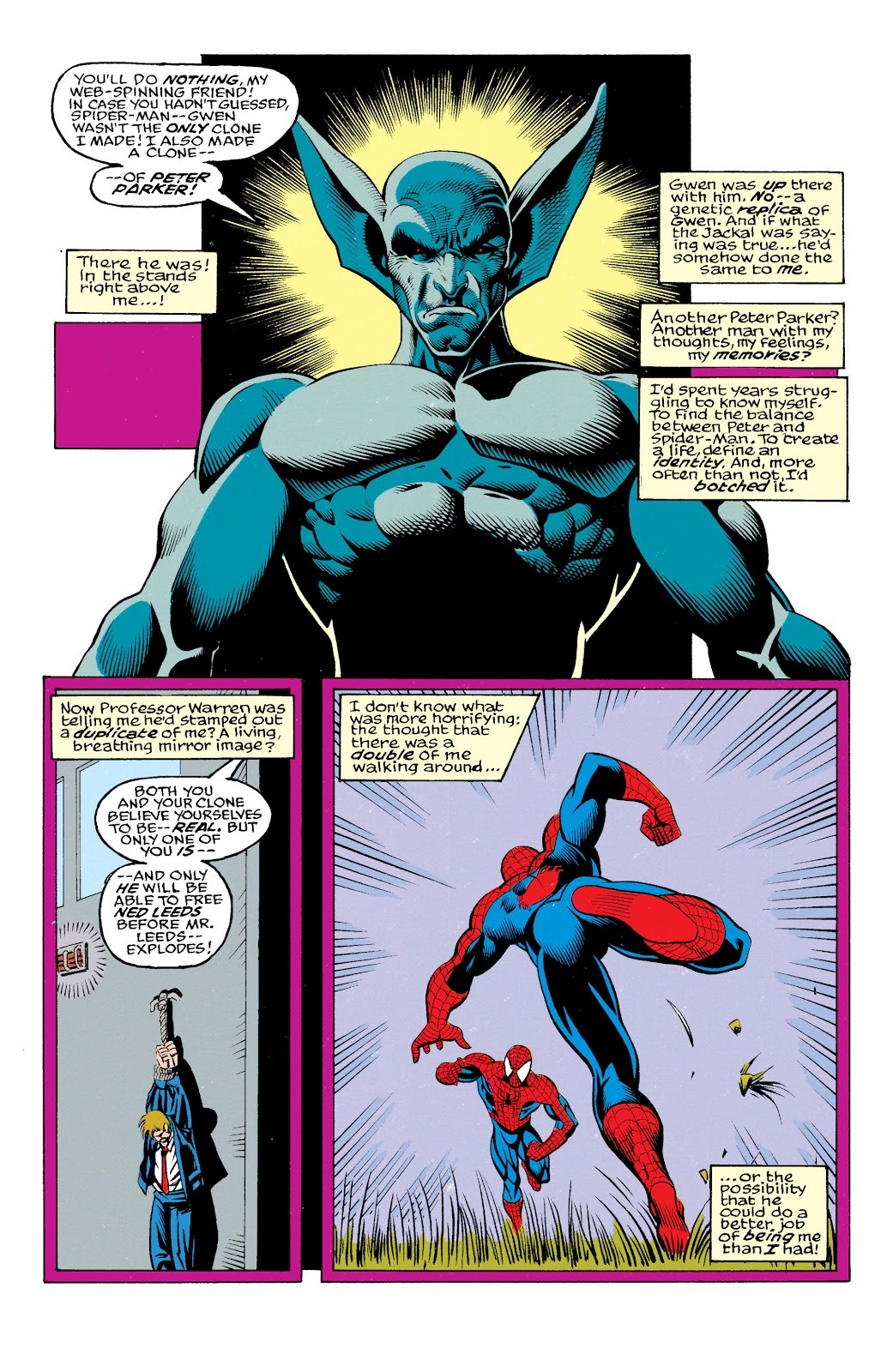
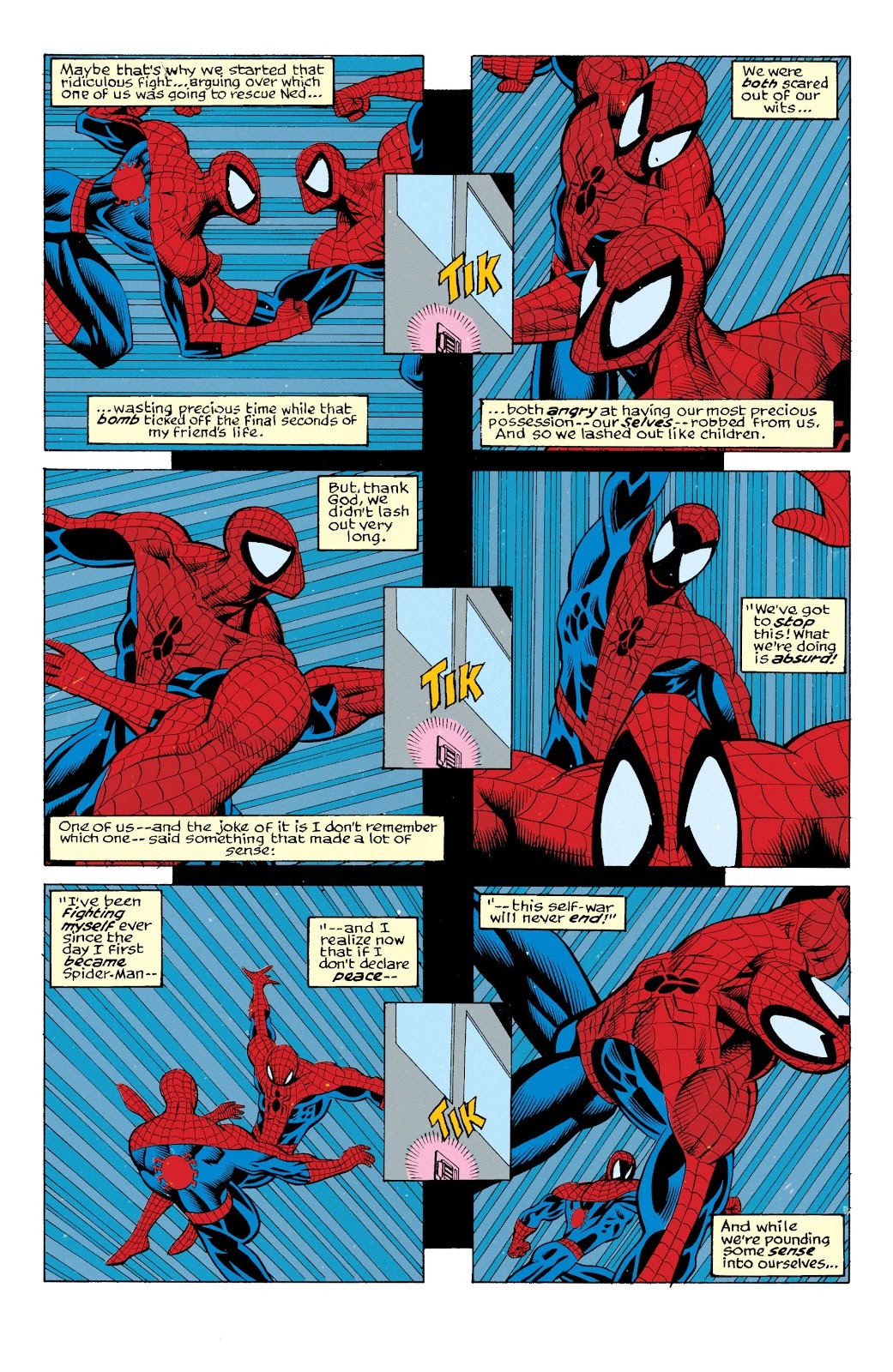
Of course this is revisited repeatedly throughout the Clone Saga, even right out the gate during Web of Spider-Man #117, the very first issue of the entire saga.

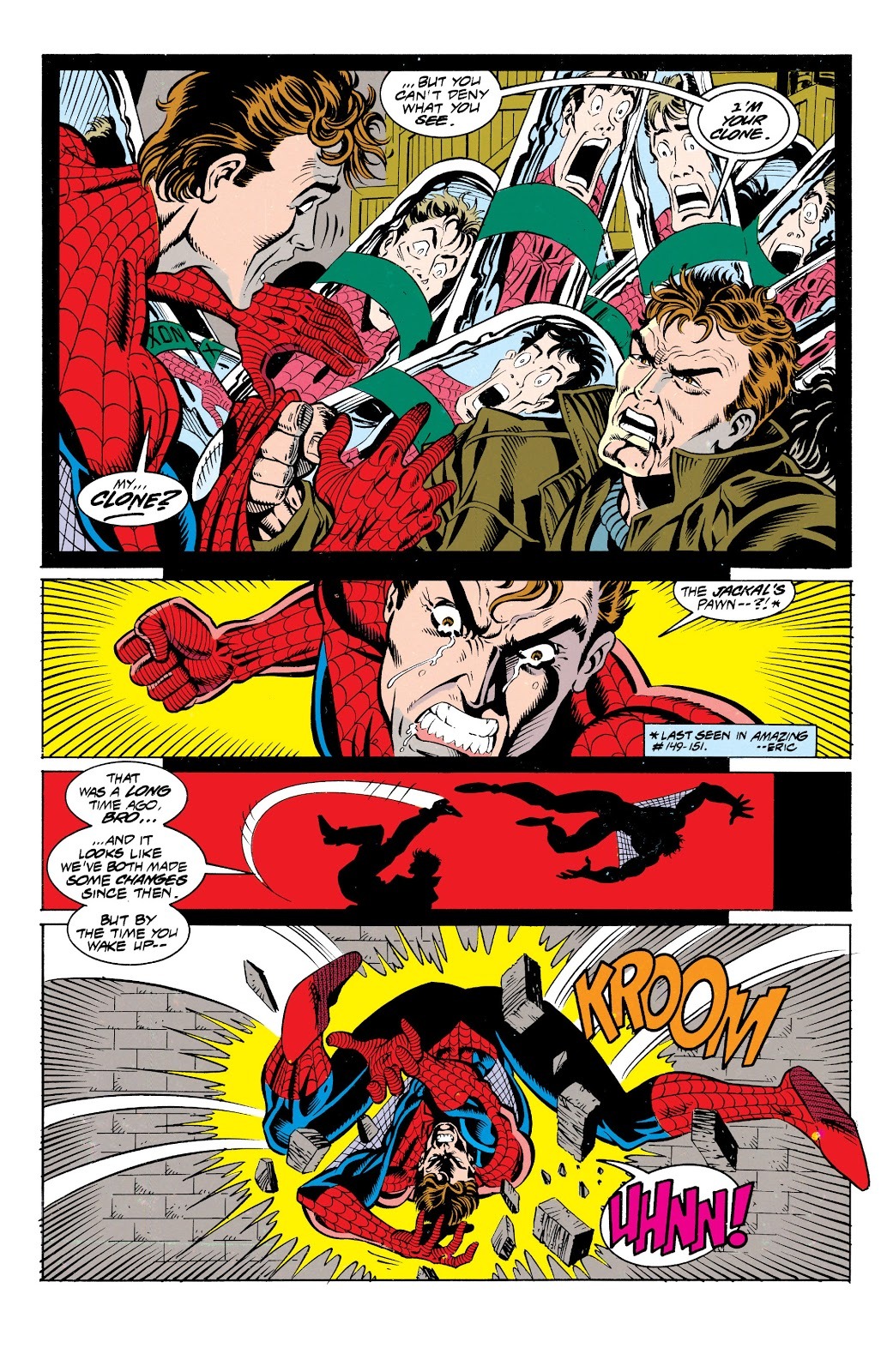
Both Peter and Ben Reilly get incredibly touchy about the idea that they might be a clone and struggle to reconcile their sense of identity and individuality.
Whilst Venom is not literally a clone of Spider-Man he does look like Spider-Man. Spider-Man is an intrinsic part of who Peter is and so the mask of Spider-Man is in a sense something Peter connects with and identifies as part of himself.
Yes this would even apply to the black costume’s mask even though he hadn’t been wearing that for as long. He still spent a lot of time in that costume and had come to accept it as his main outfit. He also spent a lot of time looking at it by virtue of it being projected at him through mass media (such as the Daily Bugle) and of course looking at it for his own photos. He’d have likely still considered it a part of himself and another of his ‘faces’.
So seeing his own ‘face’ reflected back at him in a distorted and nightmarish way (with it even verbalizing a desire to violently murder him) could have had a subtle but nevertheless seriously unnerving affect upon Spider-Man.
Whilst no Spider-Man story to my knowledge has ever outright confirmed this notion there is some precedence for it in the real world and other fictional works.
Consider Martin Seligman’s theory for a moment, the idea that we instinctively fear that which is distinctly inhuman. Well the flipside to that is that we identify and relate with things that are to our perceptions more human. On an individual basis we particularly identify and connect with people who more closely resemble ourselves than others.
This is why it is often the case that behaviours of fathers and mothers imprint upon their sons and daughters respectively. The young boy instinctively makes the connection that he is more similar to his father than with his mother and the young girl instinctively makes the connection she is more similar to her mother than her father. It is also why the old adage of men being attracted to women like their mothers and women being attracted to men like their fathers isn’t just a saying but has some basis in real world human psychology.
So human beings primal connection to the image of other human beings is intrinsic to the formation of our own identities. And our identities being tampered with can actually be incredibly unhealthy and dangerous.
This was exemplified in the case of Norah Vincent. She was a writer who for a social experiment once pretended to be a man for several months, with the experience leaving her severely depressed. During an interview about the experience she said identity was not something to be messed around with.
These identity issues can be more broadly affected when we see something we identify as human or close enough to human but warped in some way.
This is also one of the reasons body horror stories in film and other media hold a fascination for audiences. Because we are seeing the human body, the thing we all have and identify with distorted in an unnatural way.
A far more common example though would be the negative affects many people experience from viewing dead bodies. Humans are instinctively fearful of death of course so it can be disturbing for many of us when we see the dead or dying bodies of other humans, other individuals who we again inherently identify with. This is particularly pronounced if the bodies have been mutilated or disfigured in some way, hence why police officers and soldiers can develop mental illnesses in the course of their jobs.*****
This phenomenon is exemplified to an even greater degree in the Young Adult novel Scorpia Rising (part of the Alex Rider series by Anthony Horowitz). In the novel already traumatized teenage spy Alex Rider shoots and kills someone who has had reconstructive surgery to resemble himself. At the novel’s conclusion his government bosses discuss the fallout of this event.
I’ve talked to the psychologists and they say that for Alex it was almost as if he were killing himself. After all, the two of them were identical. What it boils down to is that part of Alex died with Julius Grief. He shot himself – or perhaps a part of himself that should never have been born.
For the character of Alex Rider he experienced a far more potent form of what soldiers and cops can sometimes experience due to seeing not just a dead body but the closest thing to his own dead body, which then had a negative impact upon his own sense of identity.
And all this again ties back into Seligman’s argument about biological preparedness. Our identities and sense of individuality are vitally important to us psychologically and are greatly informed by visually identifying things similar to ourselves and forming a deep connection with our own individual appearances.
Whilst Venom didn’t look like Peter Parker, he did look like a nightmarish and perverted visage of Spider-Man whom Peter identifies as part of himself.
So in confronting someone who looked like a distorted version of himself (and has his powers only better, including some abilities evoking body horror) it is as though on some level Spider-Man (somewhat similarly to Alex Rider) was fighting himself. A version of himself who wanted to violently murder him, was fully capable of doing so and whom Peter barely managed to survive against in each encounter.
Conclusion
Spider-Man’s unusual fear of Venom was the product of the above factors working in tandem. He removed Spidey’s sense of safety and personal space, evoked disturbing fears of losing his sense of agency, was overwhelmingly powerful, homicidally dangerous and had a terrifying appearance, particularly for Spidey himself who was seeing his own image and identity distorted.
His fear made complete sense from an in-universe perspective and lent Venom something unique as a villain. He was the one opponent Spider-Man was genuinely frightened of.
Whilst one could argue it undermined Spider-Man’s standing as a hero to portray him as so scared of Venom, another way of looking at it is like this.
Peter’s fear of Venom fed directly into the notion of Spider-Man as the hero who could be you. He is wonderfully flawed and so is not above feeling fear and at times giving into it. It’s part of what makes him the most human super human character in comics.
However as fearful as he was of Venom we should be wary of exaggeration. As fearful as Spidey was, as much as he desired to run away from Venom when push came to shove he did ultimately face his foe and emerged victorious. And as time went by his fear of Venom dwindled enabling him to face his foe proudly.
*Before any of you bring it up I am of course aware of Norman abducting Gwen Stacy from Peter’s apartment and leaving a pumpkin bomb as a message for him which is similar to Venom’s accosting of MJ in ASM #300. But the difference is that Norman in that instance happened across Gwen by chance and Peter didn’t actually see her being terrorized in his private space. More significantly Norman has been a known adversary of Peter’s for awhile and had been to his apartment multiple times meaning Peter might’ve been more psychologically ‘braced’ for Norman violating his personal sanctuary than a complete stranger like Venom. Venom’s anonymity probably even enhanced this effect when compared to a known quantity like Norman.
**We might also argue that the personal rivalries and vendettas between the Osborns and Peter meant that Peter transcended fear altogether. Venom might have threatened his family but he hadn’t actually hurt them. The Osborns though were tied up with the deaths of Gwen, Ben Reilly, the cruelty involving his robot parents and so many other things. Consequently Peter might have been aware of the danger their resources and knowledge of his life posed but wasn’t going to give them the satisfaction of agonizing too much over it; a sentiment echoed in Paul Jenkins ‘A Death in the Family’ arc. Or else he was so angry/hateful towards them for what they’d done to him that fear wasn’t the first or primary emotion he felt towards either of them.
***I know Mysterio, Jackal and Green Goblin have ways of bypassing the Spider Sense but they do not naturally possess such an ability. And Spidey can at least rely upon over powering any of them when push comes to shove.
****It’s possible that due to his overwhelming power and how vulnerable he made Spider-Man feel Venom might even have drawn out old insecurities Peter felt about being bullied in high school. As some food for thought regarding this consider that in ASM #258, when being controlled by the symbiote, Peter had a nightmare involving his two costumes fighting over him. During the dream he looked exactly as he did in high school.
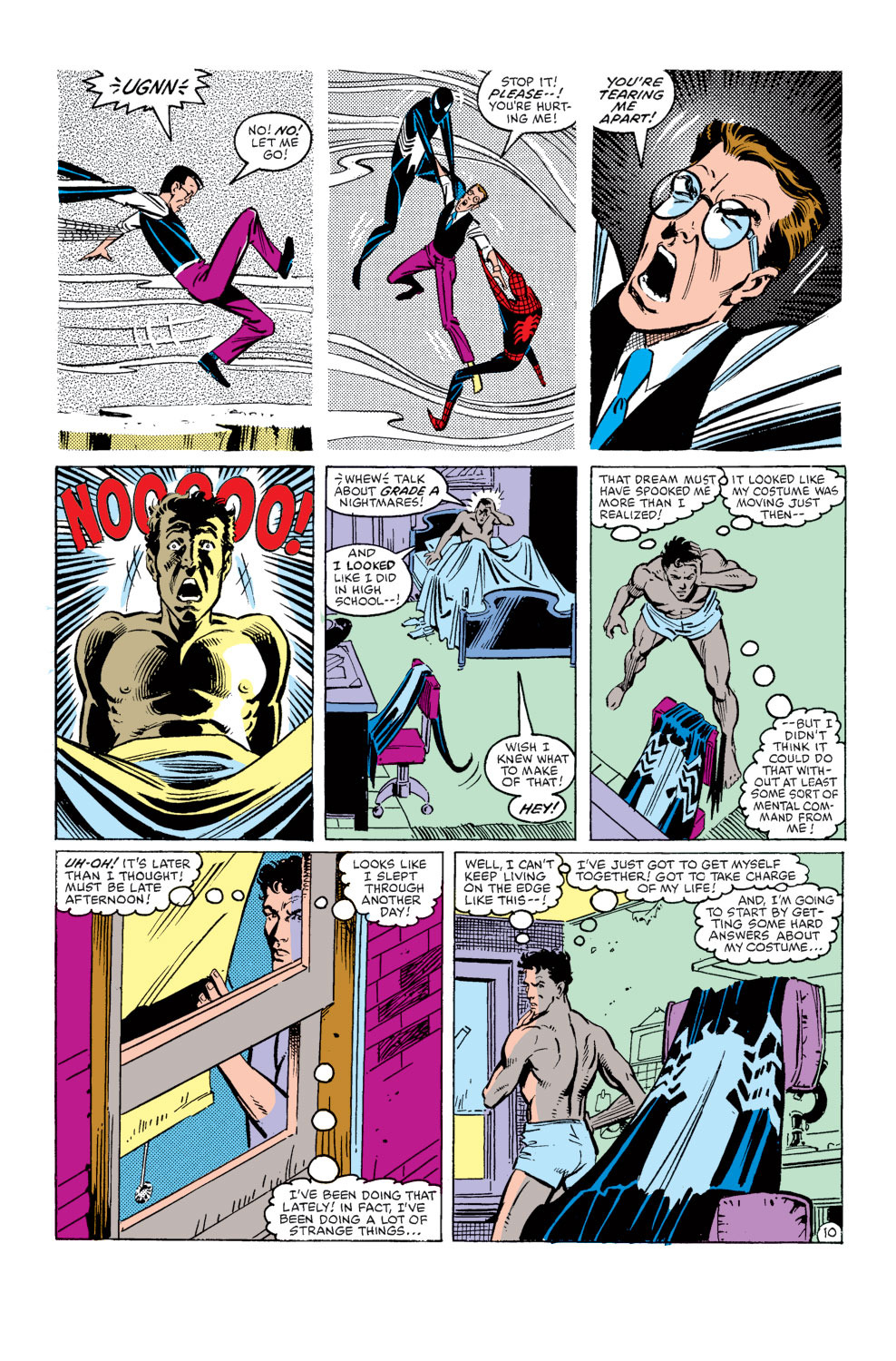
*****To give a personal anecdote I know someone who was freaked out when, as part of their medical training, they had to use their own hands to dissect another human’s hand.



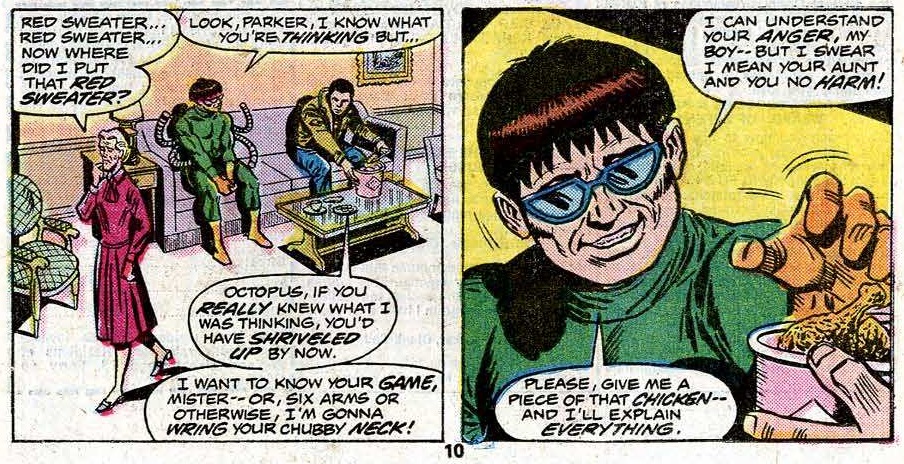
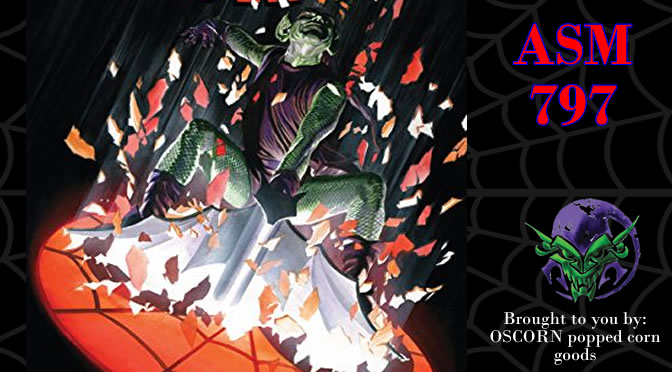





Such a fantastic column, one of the very best Spider-Man related essays I’ve read (and there have been many great pieces on this site). Thank you for your insightful analysis.
@xonathan
TBH authorial intent doesn’t matter that much.
Gerry Conway himself in his own mind believed Gwen was dead before Spidey ever showed up at that bridge and questions why if he thought that that he on a whim decided to add the snap sound effect.
There comes a point where a character and a story transcends the author themselves and I feel that for a highly collaborative form of storytelling like comics, and especially for characters that an author did not create or define, that goes even moreso.
As Stan Lee said to Spider-Man himself in the last episode of the 1994 cartoon: You aren’t the same character I’ve been writing about all these years.”
Yes him being stronger, scary/ugly and turning off spider sense was explicitly stated. But if those were the ONLY reasons for Spidey to run away then that would make him slightly coward. Those three reasons plus the other ones from your analysis make sense, but the writer never made them explicit. They fit, but who knows if that was the writer’s original intention
@xonothan I think some of my explanations can be seen within the subtext of the series.
Like Venom is scary to everyone and overwhelmingly powerful to Spidey, including the immunity to the spider sense.
Great article. I just wished the writer would have made a more explicit reason as to why Peter would run away from Venom. It just seemed that Michelinie wanted to artificially elevate Venom’s status by having Spidey run away from him thus implying Venom’s (Michelinie’s creation) superiority. But all the aforementioned explanations all make sense